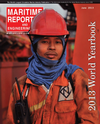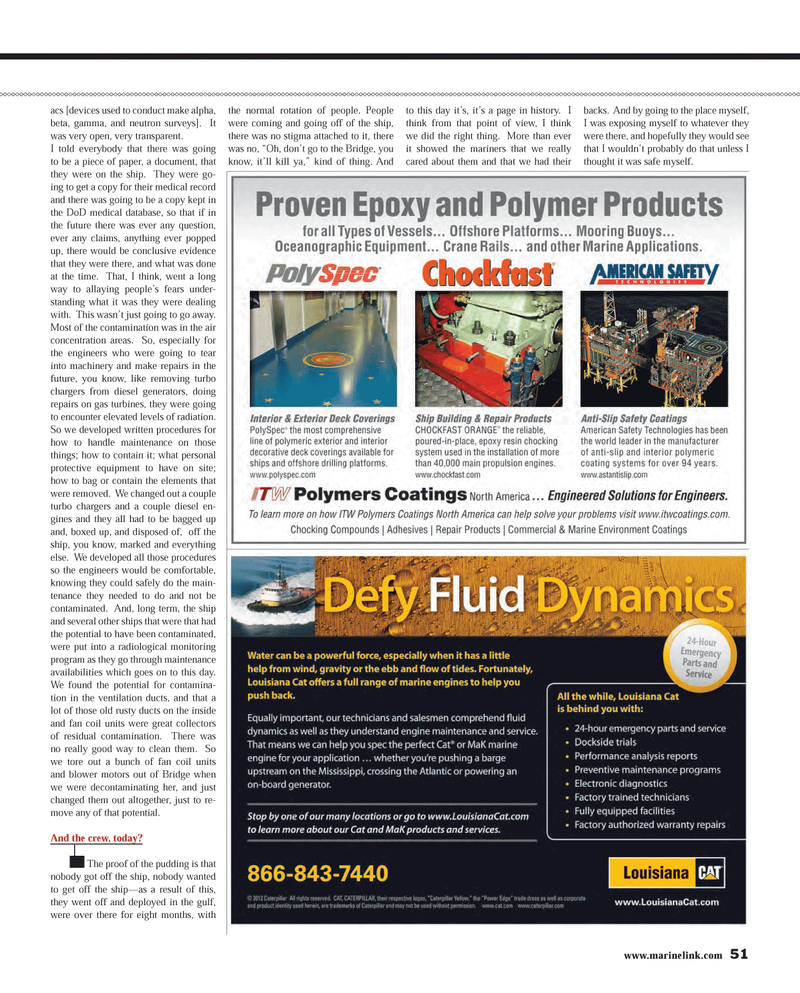
Page 51: of Maritime Reporter Magazine (June 2013)
Annual World Yearbook
Read this page in Pdf, Flash or Html5 edition of June 2013 Maritime Reporter Magazine
www.marinelink.com 51acs [devices used to conduct make alpha, beta, gamma, and neutron surveys]. It was very open, very transparent. I told everybody that there was going to be a piece of paper, a document, that they were on the ship. They were go- ing to get a copy for their medical record and there was going to be a copy kept in the DoD medical database, so that if in the future there was ever any question, ever any claims, anything ever popped up, there would be conclusive evidence that they were there, and what was done at the time. That, I think, went a long way to allaying people?s fears under- standing what it was they were dealing with. This wasn?t just going to go away. Most of the contamination was in the air concentration areas. So, especially for the engineers who were going to tear into machinery and make repairs in the future, you know, like removing turbo chargers from diesel generators, doing repairs on gas turbines, they were going to encounter elevated levels of radiation. So we developed written procedures for how to handle maintenance on those things; how to contain it; what personal protective equipment to have on site; how to bag or contain the elements that were removed. We changed out a couple turbo chargers and a couple diesel en- gines and they all had to be bagged up and, boxed up, and disposed of, off the ship, you know, marked and everything else. We developed all those procedures so the engineers would be comfortable, knowing they could safely do the main-tenance they needed to do and not be contaminated. And, long term, the ship and several other ships that were that had the potential to have been contaminated, were put into a radiological monitoring program as they go through maintenance availabilities which goes on to this day. We found the potential for contamina- tion in the ventilation ducts, and that a lot of those old rusty ducts on the inside and fan coil units were great collectors of residual contamination. There was no really good way to clean them. So we tore out a bunch of fan coil units and blower motors out of Bridge when we were decontaminating her, and just changed them out altogether, just to re- move any of that potential.And the crew, today? The proof of the pudding is that nobody got off the ship, nobody wanted to get off the ship?as a result of this, they went off and deployed in the gulf, were over there for eight months, with the normal rotation of people. People were coming and going off of the ship, there was no stigma attached to it, there was no, ?Oh, don?t go to the Bridge, you know, it?ll kill ya,? kind of thing. And to this day it?s, it?s a page in history. I think from that point of view, I think we did the right thing. More than ever it showed the mariners that we really cared about them and that we had their backs. And by going to the place myself, I was exposing myself to whatever they were there, and hopefully they would see that I wouldn?t probably do that unless I thought it was safe myself. MR #6 (50-57).indd 51MR #6 (50-57).indd 515/31/2013 1:43:04 PM5/31/2013 1:43:04 PM

 50
50

 52
52
